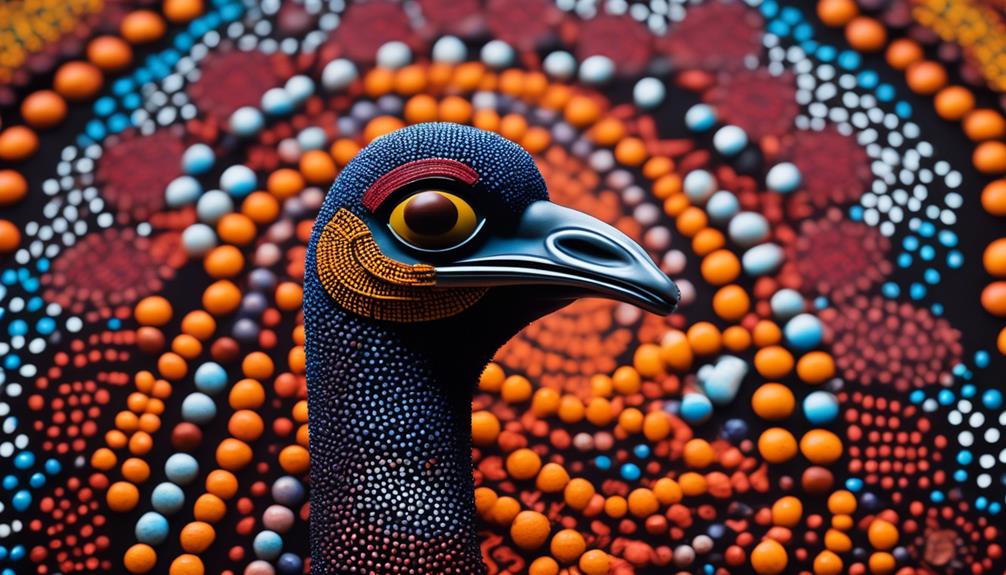
Did you know that emus are featured in various forms of art and culture around the world? From ancient art to contemporary representations, these fascinating creatures hold symbolic meaning in different societies.
Emus can be found in indigenous cultures, folklore, mythology, and even serve as icons of conservation and environmental awareness.
In this exploration of their symbolic significance, we will uncover the diverse ways emus are portrayed and celebrated, providing insight into the rich tapestry of human creativity and the deep connections we have with the natural world.
So, let's embark on this journey together and discover the intriguing world of emus in art and culture.
Emus in Ancient Art

Emus have been depicted in various forms of ancient art, showcasing their significance and symbolic meaning in cultures throughout history. In ancient art, emus were often portrayed as powerful and majestic creatures. They were frequently seen in cave paintings and rock carvings, displaying their long necks and distinctive feathers. These artistic representations of emus suggest that they held a prominent role in the lives and beliefs of ancient civilizations.
The emu's portrayal in ancient art can be interpreted in different ways. Some researchers believe that emus were seen as symbols of fertility and abundance. Their large size and ability to survive in harsh environments may have been seen as a reflection of the strength and resilience needed for successful agriculture. Others suggest that emus represented courage and bravery, as they're known for their ability to defend themselves and their young.
Emus continue to be a source of inspiration for contemporary artists. In modern art, emus are often depicted in a more abstract and stylized manner. Artists may use emus as a metaphor for freedom, independence, or even as a commentary on environmental issues. The artistic representation of emus in contemporary art reflects the ongoing fascination with these enigmatic creatures and their enduring symbolic meaning.
Emus in Indigenous Cultures
Within Indigenous cultures, the presence of emus holds deep cultural significance and is intertwined with their spiritual beliefs and traditions. Emus play a central role in traditional ceremonies, where they're seen as sacred beings that connect the physical and spiritual worlds. These majestic birds are believed to possess special powers and are often invoked to bring blessings, protection, and guidance to the community.
In Indigenous storytelling, emus are prominent characters that represent wisdom, resilience, and harmony with nature. They're often depicted as teachers, imparting valuable life lessons and ancestral knowledge to the younger generations. Through their stories, Indigenous communities pass down important cultural values and teachings, emphasizing the need for respect and balance in all aspects of life.
The emu's distinctive characteristics, such as their strong legs and ability to cover great distances, are seen as metaphors for endurance and determination. Indigenous cultures draw inspiration from the emu's behavior, using it as a symbol of perseverance and adaptability in the face of challenges.
Emus in traditional ceremonies and indigenous storytelling serve as powerful reminders of the deep connection between humans and the natural world. They embody the spiritual essence of Indigenous cultures, carrying the ancestral wisdom and cultural heritage that has been passed down for generations. Through their presence in ceremonies and stories, emus continue to inspire and guide Indigenous communities, fostering a sense of identity, unity, and reverence for the land.
Emus in Aboriginal Dreamtime Stories
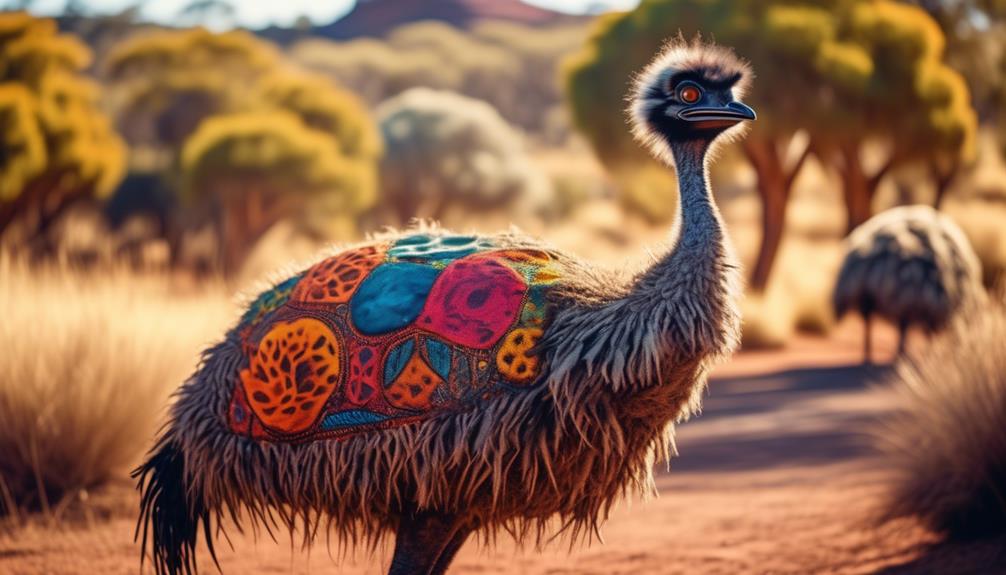
Aboriginal Dreamtime Stories are rich in cultural symbolism, weaving together the spiritual beliefs and ancestral wisdom of Indigenous communities. Emus hold a significant place in these stories, carrying with them profound meanings that continue to resonate in modern society.
In Aboriginal Dreamtime Stories, emus are often depicted as powerful and wise creatures. They're seen as custodians of sacred knowledge and are revered for their ability to navigate the physical and spiritual realms. Emus are portrayed as symbols of resilience and adaptability, teaching valuable lessons about survival and the importance of harmony with nature.
These stories also highlight the emu's role as a provider. Aboriginal communities relied on emus for sustenance, using their meat, eggs, and feathers for nourishment and various purposes. The emu's generosity and abundance in these stories serve as a reminder of the interconnectedness between humans, animals, and the land.
Furthermore, emus represent the connection between past, present, and future. They're often associated with ancestral spirits and are believed to carry the wisdom of the elders. Through their presence in Dreamtime Stories, emus remind us of the importance of preserving Indigenous knowledge and honoring the wisdom of our ancestors.
In modern society, the symbolism of emus in Aboriginal Dreamtime Stories continues to hold relevance. It serves as a reminder of the deep spiritual connection between humans and the natural world, urging us to respect and care for the environment. Emus also inspire us to embrace resilience, adaptability, and the wisdom passed down through generations.
Emus in Mythology and Folklore
As we explore the realm of mythology and folklore, we uncover captivating tales that further illuminate the symbolic significance of emus in indigenous cultures. Emus have long been featured in the literature and oral traditions of various ancient civilizations, where they're often associated with profound meanings and spiritual beliefs.
- In Aboriginal Dreamtime stories, emus are revered as sacred beings who possess great wisdom and knowledge. They're believed to have played a crucial role in the creation of the world and continue to guide and protect the Aboriginal people.
- Emus are also prominent figures in the religious beliefs of many indigenous cultures. In some mythologies, they're seen as messengers between the earthly and spiritual realms, carrying prayers and messages to the gods.
- In literature, emus often symbolize resilience and endurance. Their ability to survive in harsh environments and their strong, swift movements are seen as metaphors for overcoming challenges and persevering in the face of adversity.
- Additionally, emus are sometimes associated with fertility and nurturing. In certain folktales, they're depicted as caring and protective parents, embodying the qualities of love, compassion, and devotion.
These myths and stories not only showcase the cultural significance of emus but also highlight the deep connection between humans and nature. They remind us of the power and wisdom that can be found in the natural world, urging us to respect and cherish the creatures that share our planet.
Emus in Contemporary Art
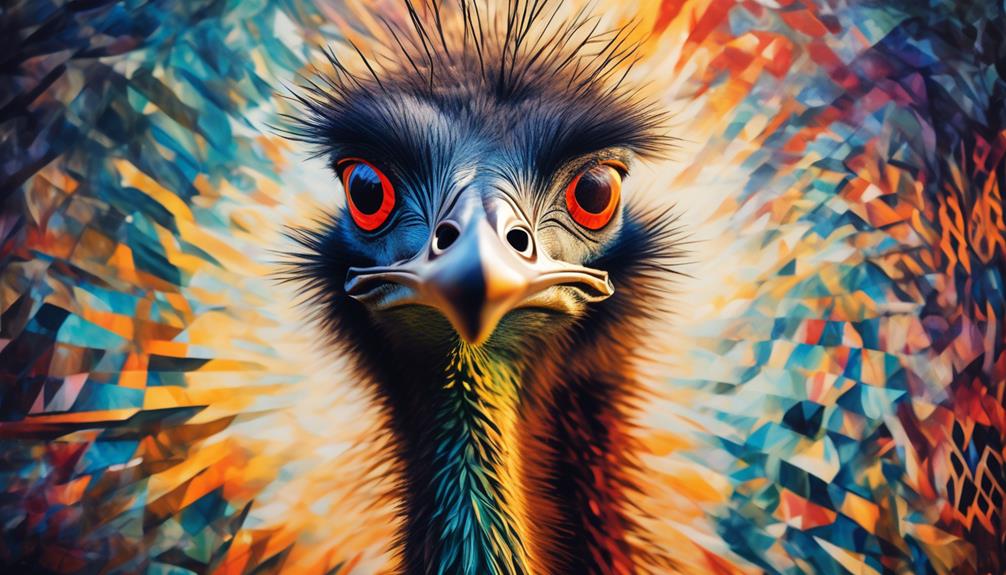
Emus have made their mark in contemporary art, captivating audiences with their unique presence and symbolic significance. These majestic birds have found their way into the world of fashion, becoming an integral part of contemporary fashion trends. From emu feather accessories to emu-inspired prints, designers have embraced the emu's elegance and grace, incorporating them into their collections. The emu's distinctive feathers, with their rich brown color and soft texture, add a touch of natural beauty to garments and accessories.
In addition to fashion, emus have also become prominent figures in advertising campaigns. Advertisers recognize the emu's symbolic associations with strength, resilience, and independence, making them the perfect choice to convey powerful messages. Emus are often depicted in these campaigns as confident and assertive creatures, embodying the spirit of their brand.
Contemporary artists have also been inspired by the emu's symbolism, using it as a means of exploring themes such as identity, freedom, and connection to nature. Through their artwork, they invite viewers to reflect on their own place in the world and the significance of these magnificent birds. The emu's presence in contemporary art serves as a reminder of the deep cultural and spiritual connections we have with nature and the importance of preserving it for future generations.
Symbolism of Emus in Art
In the realm of art, emus hold a profound symbolic significance, inviting you to delve into the depths of meaning and explore the intricate connections between humanity and the natural world. Emus have been a source of inspiration for artists across various mediums, including literature and religious symbolism.
Here are four fascinating ways emus have been depicted in art:
- Emus in literature: Emus have been featured in numerous literary works, often representing resilience, adaptability, and a connection to the land. Their graceful movements and ability to survive in harsh environments make them powerful symbols of endurance and strength.
- Emus in religious symbolism: In certain indigenous cultures, emus are revered as sacred animals, embodying spiritual qualities and serving as messengers between the earthly realm and the divine. They're associated with wisdom, protection, and guidance, offering a spiritual connection to the natural world.
- Emus as symbols of regeneration: The unique reproductive behavior of emus, where the male takes on the role of incubation and rearing the offspring, has inspired artists to depict them as symbols of rebirth and renewal. This imagery highlights the importance of nurturing and caretaking in the cycle of life.
- Emus as representations of freedom: The emu's ability to move swiftly and effortlessly across vast landscapes has made it a symbol of freedom and liberation in art. Artists often portray emus in motion, capturing their grace and agility to evoke a sense of liberation and the boundless possibilities that come with it.
Through their presence in literature and religious symbolism, emus in art offer a rich tapestry of meanings, connecting us to the natural world and inviting us to reflect on our place within it.
Emus as Spiritual and Totem Animals
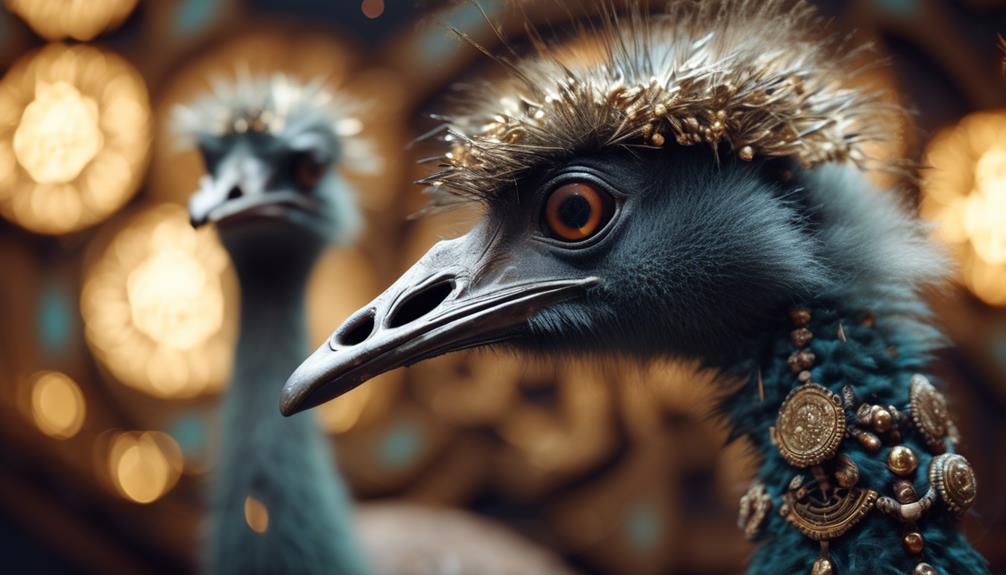
Emus, with their enigmatic presence and spiritual significance, offer profound insights into the realm of spirituality and totemism. These magnificent birds have long been revered as spirit guides in various indigenous cultures around the world. Emus are seen as messengers from the divine, bridging the gap between the physical and spiritual realms.
In shamanic practices, emus are believed to possess the power to connect individuals with their higher selves and the spiritual world. Shamans often call upon the energy of the emu to gain wisdom, guidance, and protection during their spiritual journeys. The emu's ability to navigate both the earth and the sky is seen as symbolic of their ability to transcend the mundane and reach higher spiritual planes.
As totem animals, emus are associated with qualities such as strength, patience, resilience, and intuition. They teach us the importance of grounding ourselves in the present moment, while also encouraging us to explore the depths of our own spirituality. Emus remind us to trust our instincts, to be adaptable in the face of challenges, and to embrace our unique path in life.
Emus as Symbols of Strength and Resilience
With their symbolic connection to spirituality and totemism, emus offer profound insights into the realm of strength and resilience. These majestic birds have long been revered as symbols of endurance and fortitude. Here are four ways in which emus embody these qualities:
- National Symbols: In Australia, emus are considered national symbols, representing the country's strength and resilience. Their ability to adapt and survive in harsh environments reflects the tenacity of the Australian people.
- Physical Attributes: Emus possess remarkable physical attributes that contribute to their strength and resilience. Their long legs enable them to cover vast distances, and their powerful muscles allow them to run at high speeds. Their endurance in traversing the arid Australian landscape is a testament to their resilience.
- Parental Care: Emus are known for their exceptional parental care. The male takes on the responsibility of incubating the eggs and raising the chicks, demonstrating their dedication and resilience in the face of challenges.
- Survival Instincts: Emus have evolved to be highly adaptive creatures, capable of surviving in various habitats. Their ability to find food, water, and shelter even in harsh conditions showcases their resilience and determination to thrive.
Emus in Australian Culture
Emus play a significant role in shaping the cultural fabric of Australia, with their presence deeply woven into various aspects of the nation's heritage. Throughout Australian history, emus have been revered for their resilience and adaptability, making them symbolic of the Australian spirit. These magnificent birds have captured the imagination of artists, writers, and poets, becoming an integral part of the country's cultural identity.
In Australian history, emus have been depicted in various forms of art, including paintings, sculptures, and indigenous cave paintings. They're often seen as a symbol of survival and endurance, representing the indomitable spirit of the Australian people. Emus have also played a crucial role in the country's culinary traditions. Emu meat, known for its rich flavor and lean texture, has become a popular ingredient in Australian cuisine. It's often used in dishes such as emu steaks, burgers, and sausages, showcasing the country's love for unique and sustainable food sources.
Emus in Australian culture are more than just a symbol or a source of food; they embody the spirit of the land and its people. Their presence in art and cuisine reflects the deep connection Australians have with their environment and their ability to adapt and thrive in challenging circumstances. Emus aren't just birds; they're an integral part of the Australian story.
Emus in Global Art and Cultural Influences
In the realm of global art and cultural influences, emus have made their distinctive mark, captivating audiences with their unique symbolism and captivating presence. These majestic birds have inspired various forms of artistic expression and have left a lasting impact on fashion and culinary traditions around the world.
Emus in modern fashion: Emus have become a source of inspiration for designers, who incorporate their elegant feathers and graceful movements into clothing and accessories. From emu feather-adorned dresses to handbags and jewelry, these creations embody the spirit and grace of the emu, adding a touch of natural beauty to the fashion industry.
Emus in culinary traditions: Emu meat has gained popularity in recent years for its lean and flavorful qualities. Chefs around the world have embraced emu meat as a versatile and sustainable ingredient, incorporating it into various dishes. From emu steaks and burgers to emu jerky and sausages, these culinary creations highlight the unique taste and nutritional value of emu meat.
Emus in art exhibitions: Emus have found their way into art exhibitions, captivating audiences with their symbolism and beauty. Artists have depicted emus in various mediums, including paintings, sculptures, and installations, exploring their significance in different cultures and contexts.
Emus in cultural festivals: Emus have become an integral part of cultural festivals in many countries. Whether as performers in parades or as symbols of strength and resilience, emus are celebrated for their connection to nature and their representation of cultural heritage.
Emus' influence on global art and cultural traditions demonstrates their enduring appeal and the profound impact they've on human creativity and imagination.
Emus as Icons of Conservation and Environmental Awareness
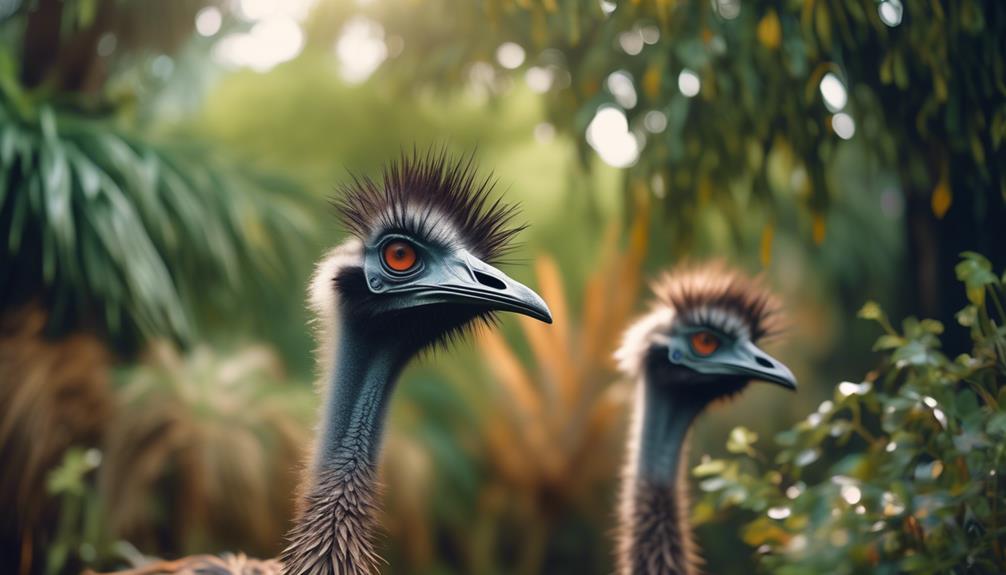
As symbols of conservation and environmental awareness, emus embody the delicate balance between human progress and the preservation of our natural world. Their image has been utilized in various ways to promote and advocate for the protection of our environment.
Emus have become popular mascots for sports teams, representing the values of strength, adaptability, and resilience that are essential in the face of environmental challenges. By incorporating emus into their branding, these teams communicate their commitment to sustainable practices and inspire their fans to take action towards conservation.
Furthermore, emus have also been featured in advertising campaigns aimed at raising awareness about environmental issues. Their unique appearance and association with the Australian outback evoke a sense of connection to nature, making them powerful symbols to convey the importance of environmental stewardship. Whether it's promoting renewable energy, reducing plastic waste, or preserving wildlife habitats, emus help to captivate audiences and encourage them to become active participants in environmental conservation efforts.
In addition to their visual impact, emus also possess symbolic qualities that resonate with the ethos of conservation. Their ability to survive in harsh environments and their role in maintaining ecosystem balance highlight the importance of preserving biodiversity and protecting fragile ecosystems. Emus serve as reminders that our actions have consequences on the natural world and that we must strive to live in harmony with nature for the benefit of future generations.
Frequently Asked Questions
Are Emus Considered Sacred in Any Indigenous Cultures?
Emus are considered sacred in some indigenous cultures. They serve as totems, representing strength and resilience. Emus are often incorporated into rituals, symbolizing connection to the land and ancestral spirits. Their significance is deeply rooted in indigenous traditions.
How Are Emus Represented in Contemporary Art Forms?
In contemporary art, emus burst onto the scene as captivating subjects, their majestic presence heightened through vibrant colors and bold brushstrokes. In performance art, they dance with grace, their movements captivating audiences.
Do Emus Have Any Specific Symbolic Meaning in Aboriginal Dreamtime Stories?
In Aboriginal Dreamtime stories, emus hold significant symbolic meaning. They are often associated with creation, fertility, and the balance between the physical and spiritual realms. These stories highlight their indigenous cultural significance.
Are There Any Famous Artworks or Sculptures That Feature Emus?
Have you ever wondered about the presence of emus in famous sculptures and iconic paintings? Prepare to be amazed as we delve into the world of art and explore the symbolic meaning behind these magnificent creatures.
How Have Emus Been Depicted in Global Art and Cultural Influences Beyond Australia?
Emus have been depicted in global art and cultural influences beyond Australia. In European folklore, they symbolize wisdom and endurance, while in Asian mythology, they represent loyalty and protection. These representations reflect the universal appeal of emus.
Conclusion
As you reach the end of this exploration into the symbolic meaning of emus in art and culture, you can't help but marvel at the depth of their significance.
From ancient art to contemporary representations, emus have stood as symbols of strength and resilience. They hold a special place in Australian culture and have even influenced global art and conservation efforts.
Emus are more than just majestic creatures; they're icons that remind us of the power and beauty of nature.




